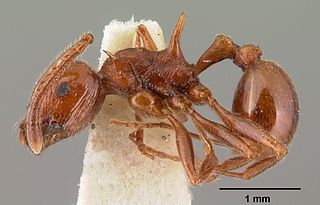| Dacetinops | |
|---|---|
 | |
| Dacetinops cirrosus worker | |
| Scientific classification | |
| Kingdom: | |
| Phylum: | |
| Class: | |
| Order: | |
| Family: | |
| Subfamily: | |
| Tribe: | |
| Genus: | Dacetinops Brown & Wilson, 1957 |
| Type species | |
| Dacetinops cibdelus Brown & Wilson, 1957 | |
| Diversity [1] | |
| 7 species | |
Dacetinops is a genus of ants in the subfamily Myrmicinae. [2] Its seven species are known from Borneo (D. cirrosus, D. concinnus, D. solivagus and D. wilsoni), and Papua New Guinea (D. cibdelus, D. darlingtonl and D. ignotus). One species, D. cirrosus, is known also from Terengganu and Johor, West Malaysia. [3]
A genus is a taxonomic rank used in the biological classification of living and fossil organisms, as well as viruses, in biology. In the hierarchy of biological classification, genus comes above species and below family. In binomial nomenclature, the genus name forms the first part of the binomial species name for each species within the genus.

Ants are eusocial insects of the family Formicidae and, along with the related wasps and bees, belong to the order Hymenoptera. Ants evolved from wasp-like ancestors in the Cretaceous period, about 140 million years ago, and diversified after the rise of flowering plants. More than 12,500 of an estimated total of 22,000 species have been classified. They are easily identified by their elbowed antennae and the distinctive node-like structure that forms their slender waists.
In biological classification, a subfamily is an auxiliary (intermediate) taxonomic rank, next below family but more inclusive than genus. Standard nomenclature rules end subfamily botanical names with "-oideae", and zoological names with "-inae".
Contents
The genus was first described with the type species D. cibdelus by Brown & Wilson (1957), based on workers, dealate queens and larvae collected by Wilson near Lae, Papua New Guinea. Ants of the genus had previously been collected 50 years earlier in the Astrolabe Bay area, Papua New Guinea, but the specimen were placed unsorted in the collections of the Hungarian Natural History Museum, where they remained until recognized by Taylor (1985). [3]

In zoological nomenclature, a type species is the species name with which the name of a genus or subgenus is considered to be permanently taxonomically associated, i.e., the species that contains the biological type specimen(s). A similar concept is used for suprageneric groups called a type genus.

Edward Osborne Wilson, usually cited as E. O. Wilson, is an American biologist, naturalist, and writer. His biological specialty is myrmecology, the study of ants, on which he has been called the world's leading expert.

Lae is the capital of Morobe Province and is the second-largest city in Papua New Guinea. It is located near the delta of the Markham River and at the start of the Highlands Highway, which is the main land transport corridor between the Highlands region and the coast. Lae is the largest cargo port of the country and is the industrial hub of Papua New Guinea. The city is known as the Garden City and home of the University of Technology.
















